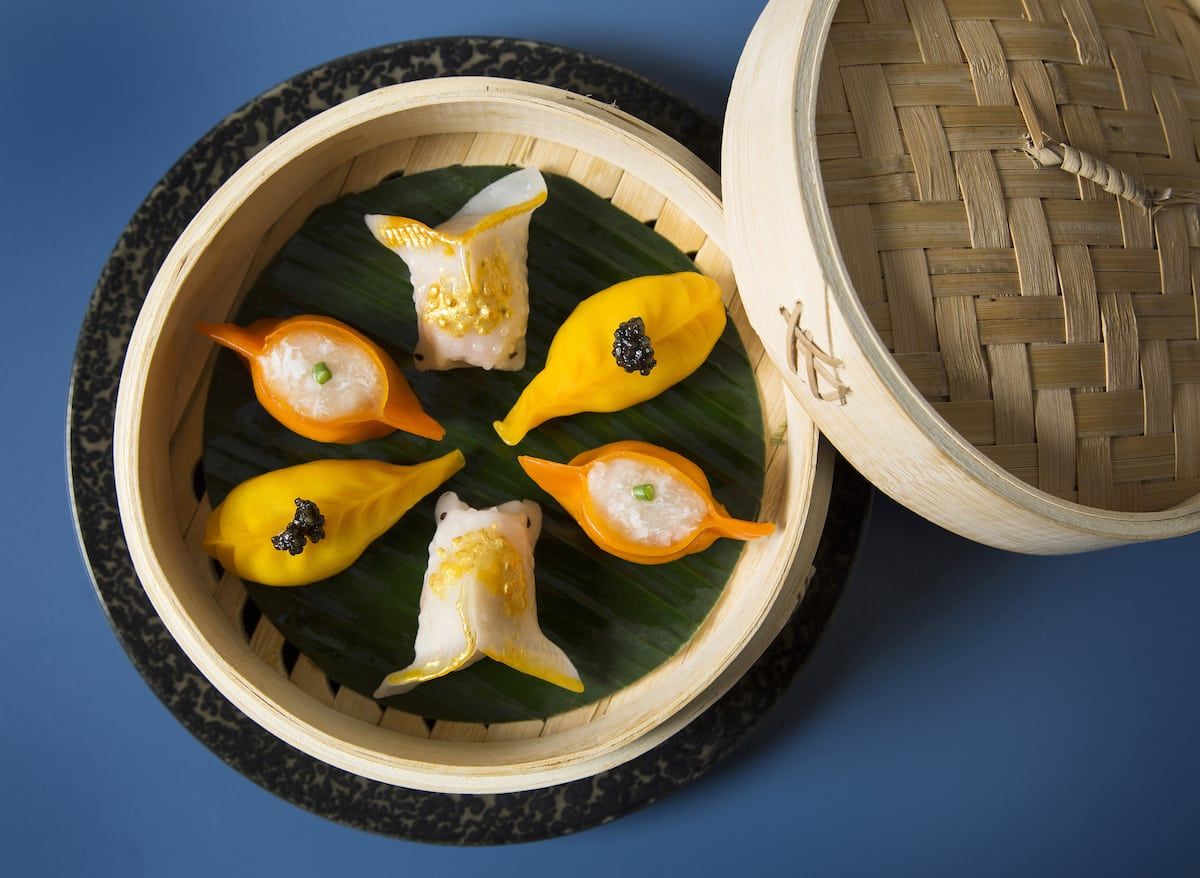Although we’re well aware that China is larger than Europe, and the continued exploration of various regional dishes and ingredients is no bad thing – we often forget that Britain’s love of Chinese food is largely rooted in Cantonese cuisine. With a Michelin-starred restaurant in Hong Kong, Duddell’s opened in London last year, taking over the former St. Thomas’ Church near London Bridge station.
Past the external structure, concealed with scaffolding, the restaurant is vast yet quite cosy. A pallet of deep blue is rich against the building’s original mahogany altar and wall-panelling. Brass chandeliers are similar to Medieval Baronial Candelabras and the M.C. Escher evocative geometric flooring is equally chic. In keeping with the décor, the service is suitably slick; competent but never intrusive. During evening service, the lighting is low, lending a sedate atmosphere against the intentions of the room’s pugnacious acoustics. Duddell’s can’t be blamed for the lofty ceiling that promotes a tornado of noise, swelling other conversations – but the lack of soft furnishing doesn’t help. The music isn’t too loud, but even the playlist’s 1970s soul hits morph into a cacophony of throbbing bass, like blaring garage music that seeps from your neighbourhood drug dealer’s car at two o’clock each morning.
As is the case at the Hong Kong original, the Cantonese food served at Duddell’s London has an unequivocal fine dining slant. Head Chef Daren Liew has a background working in the kitchens of the Hakkasan group and his menu, like many Cantonese menus, is vast. And like many good Chinese restaurants, the lunchtime offering is abundant with dim sum. In the evening, a pan-fried chicken dumpling is available alongside a “symphony” of three (two of each, per portion) seafood dumplings (£16). All three are technically very well executed, markedly classic in technique, yet there’s an evident lack of pork. Best of the three is a prawn and scallop dumpling encased in a thin translucent wrapper, closely followed by the sweet King crab filling. Though intricately shaped like a goldfish, the prawn and lobster dumpling has menial depth of flavour.

Since opening, the restaurant’s Peking duck (£38 for half, £72 whole) has received plenty of attention, and quite rightly so. Served in two courses, the duck is prepared tableside, bereft of its brittle skin that shines as though doused with hairspray. Of the skin and fat-coated meat’s large (somewhat unnecessary) selection of accompaniments – such as hoi sin sauce, peanut and sesame sauce, pineapple, cucumber and spring onion – fennel-spiked sugar has a transcendent quality that elevates the already sweet, rich, delightful flavour. The second course is available stir-fried in one of three sauces: Martell black pepper, truffle, or spring onion and ginger. We choose the latter, though the sauce is so pungent with black pepper and an earthen taste of Shimeji mushrooms; I’d perhaps be correct in assuming there’s very little difference between the sauces, if any.
A modern pick from the menu, four slices of beef foie gras toast (£12) resemble French Madeleines, topped with a generous scattering of sesame seeds. Although deep-fried, the bread is greaseless, with the liver filling a decadent evolution from classic prawn. Favouring famed Poulet de Bresse chicken from France, Cantonese soya chicken (£26) is poached in a stock of soya sauce and spice then smoked with jasmine tea leaf, the skin lashed with hot oil in order for it to crisp, not unlike the duck. The chicken breast is surprisingly saved from becoming stripped of moisture, ensnared by taut skin that’s slightly dried and texturally satisfying. Served in a paper bag, the cooking of the chicken is technically brilliant, but the dish lacks outstanding depth – failing to set the world on fire in the same manner as the superlative Peking duck.
On the side, a heap of egg fried rice (£14) is spiked with plenty of scallop and scant truffle, naturally marvellous alongside the egg. Again, the dish is technically fine and unexpectedly greaseless. To finish, desserts have a slight French twist. A free-standing crème brûlée is sating, demonstrating plenty of technical skill, though it’s the accompanying shelf of gingerbread with candied citrus flesh that’s most palatably rewarding. The case is very much the same with a prettily presented, sharp yuzu tart harbouring a biscuit base. A welcome palate cleanser to complete a dinner of technically accomplished (albeit expensive) high-end Cantonese food.
Duddell’s London can be found at 9a St Thomas Street, London, SE1 9RY.
RELATED
https://www.thelondoneconomic.com/food-drink/restaurant-review-xu/08/11/
https://www.thelondoneconomic.com/food-drink/best-street-food-chinatown-in-london/23/11/
https://www.thelondoneconomic.com/food-drink/restaurant-review-a-wong/04/07/
https://www.thelondoneconomic.com/food-drink/restaurant-review-mei-ume/11/08/

